[Ten years since the Great East Japan Earthquake Vol. 2] Fukushima and Chornobyl: Creating the future through scientific research and sharing the lessons learned
2021.03.10
Ten years have passed since the earthquake and tsunami which led to the disaster at the Fukushima Daiichi Nuclear Power Plant. There are still people who are unable to return to their hometowns located within the Difficult-to-Return zones. Another 25 years prior to that, in April 1986, the Chornobyl nuclear power plant disaster occurred in Ukraine (former Soviet Union). The town near the reactor became uninhabitable, and even now, after 35 years, there is still an Exclusion Zone of 2,577 square kilometers (about 1.2 times the area of Tokyo) in Ukraine alone.
An international joint research project linking Fukushima and Chornobyl is currently underway with the aim of scientifically investigating and researching the environment contaminated by the nuclear power plant accident for the benefit of the future. The Institute for Environmental Radioactivity (IER) at Fukushima University is playing a leading role in this project, conducting research on radioactive substances using the latest environmental monitoring and analysis technology. We covered the developments toward the reuse of such contaminated land.
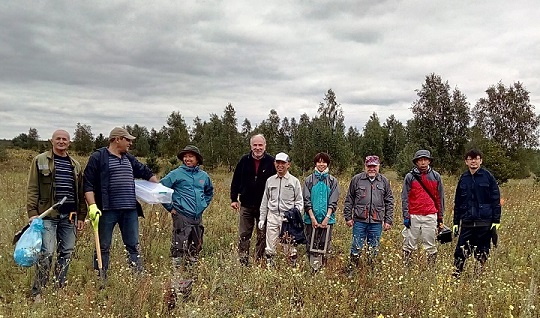
Members of Fukushima University, Tsukuba University, and Ukrainian research institutes conduct observational surveys in the Chornobyl Exclusion Zone
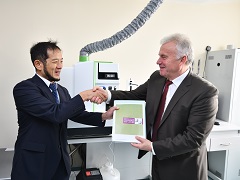
Project leader Professor Nanba (left) and the rector of the National University of Life and Environmental Sciences of Ukraine (NUBiP) Professor Stanislav Nikolaienko (right) sharing the latest instruments and analytical methods to conduct research to support policy making in Ukraine and the future of Fukushima
Professor NANBA Kenji, director of Fukushima University’s IER, describes the progress of the project saying, “The knowledge gained from the regular and continuous radiation monitoring (measurement and surveillance) at Fukushima and its analysis methods has helped us to better understand the status and movement of radioactive substances at Chornobyl. Our findings have been published in international conferences and journals.”
The IER was established in 2013 in response to the disaster at the Fukushima Daiichi Nuclear Power Plant. It conducts surveys and observations of the behavior of radioactive substances in the ecosystems of forests, rivers, and oceans and the effects on living creatures in these ecosystems. The IER uses the latest numerical simulation technology to develop scientific knowledge.
Professor Nanba explains the basic relationship between the two. “Naturally, Chornobyl, which was hit by disaster first, has a long history of research and knowledge. On the other hand, in the 25 years leading up to the accident at the Fukushima Daiichi Nuclear Power Plant, science and technology have advanced greatly. In particular, since the 1990s, methods and instruments for efficiently and precisely measuring strontium-90 and cesium-137 have evolved dramatically. For the analysis of environmental monitoring and the dynamic modeling of radioactive substances based on this data, we can utilize the knowledge of Fukushima, which is the latest and up to date.”
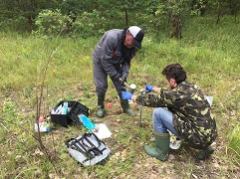
Collecting soil for radioactivity study in the Chornobyl Exclusion Zone
One example of the wide-ranging project is the environmental survey of the area surrounding the cooling ponds that were contaminated by the disaster. Due to the plant being decommissioned, the water level in the ponds was drawn down after the water supply was cut off in 2014. To check the environmental changes caused by this, surveys were conducted on the radioactive substances in the pond water and the surrounding soil of newly emerged land as well as the dike of the pond. Various observations and analyses related to radioactive substances in the environment are being conducted, including research on the biological effects of captured aquatic organisms such as fish and wild small mammals on the surrounding land, and observation of groundwater by excavating wells.
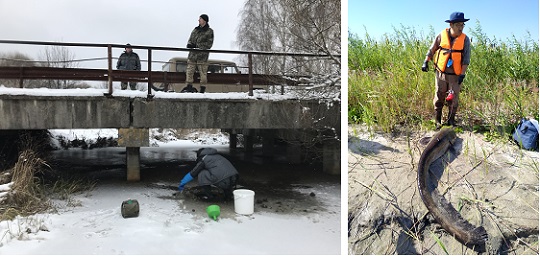
A river survey in the Exclusion Zone (left)
Investigating the effects on large catfish and other fish captured in a cooling pond (right)
Mark Zheleznyak, a professor at the IER since 2013, who has been conducting environmental surveys and research on the surrounding rivers since immediately after the Chornobyl nuclear disaster in 1986, explains the significance of this project.
“Nearly 35 years have passed since the Chornobyl disaster. Shelters are being built to cover the Sarcophagus (“the New Safe Confinement structures”), and the Ukrainian government is planning to revamp the Exclusion Zone. In order to implement these efforts safely and appropriately, it is vital to first accurately understand the amount of radioactive substances in the area and the status of their migration. Through joint research with Japan, it is possible to conduct investigation and monitoring using the most advanced analytical instruments in Ukraine. We also have much to learn, such as sharing information on the establishment of evacuation zones and the lifting of evacuation orders based on environmental monitoring in Fukushima.”
About 2.9 million people live in the capital city of Kyiv, located about 100 km south of the Chornobyl nuclear power plant. For the safety and security of the residents, it is essential to strengthen the system to constantly monitor the re-diffusion of radioactive substances.
In April 2020, a forest fire broke out in the Chornobyl Exclusion Zone, destroying approximately one-third of the area. It took about a month to extinguish the fire. At that time, false information about the “large-scale re-diffusion of radioactive substances” was disseminated throughout the world without being verified.
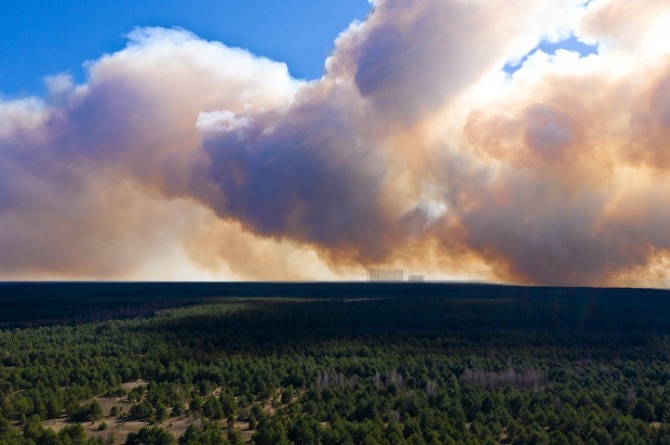
Forest fires in the Exclusion Zone in April 2020
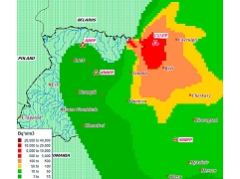
Simulation outcome of cesium-137 concentration in the atmosphere as a result of forest fires in the Exclusion Zone in April 2020 (an extraction from Talerko et al., 2021 Atmos. Pollut. Res.)
“The monitoring of radioactive substances from the forest fires in the Chornobyl area was one of our initial tasks, and we conducted detailed observations using drones. We also used an impactor to collect and study the atmosphere in Kyiv. Although there was an increase in the amount of cesium-137 from before the fires, we observed that the amount was far below the permissible level for Ukraine. By disseminating information based on scientific evidence to the press from the IER which is a joint research institute, we believe that we were able to somewhat prevent the risk of false information spreading,” says IGARASHI Yasunori, a specially appointed assistant professor at the institute, describing some of the achievements of this project.
As the 10th anniversary of the Great East Japan Earthquake approaches, Professor Nanba speaks about the future of the project as follows.
“The goal of this international joint project is to link the results of the diverse research conducted in both countries to the policy decisions of the Ukrainian government. Through comparative research between Chornobyl and Fukushima, we hope to uncover previously unknown phenomena and provide clues for predicting the future of Fukushima. We would like to continue to disseminate the lessons and scientific findings from the Chornobyl and Fukushima nuclear disasters not only within the two countries but also to the world while Japanese and Ukrainian collaboration continues. Moreover, the IER is continuing to provide a platform both for global researchers to interact with each other and for the general public, mainly in Fukushima, to discuss the results of our research. We will continue to report our findings with clarity and provide detailed information in academic papers as well as in public lectures and seminars for junior and senior high school students.”
scroll